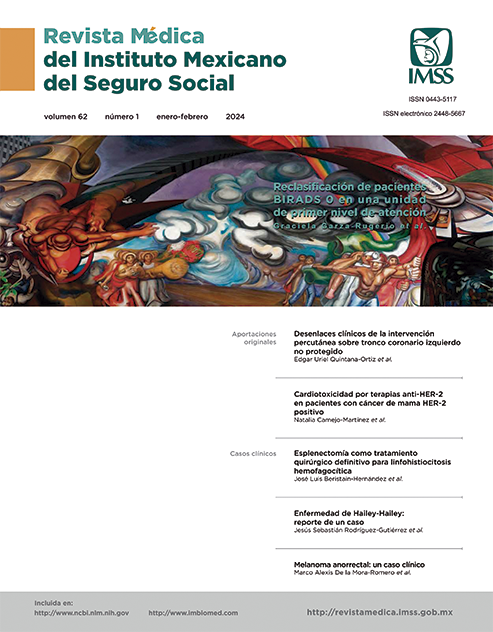Hailey-Hailey disease: A case report
Main Article Content
Keywords
Hailey-Hailey Disease, Benign Familial, Pemphigus, Blister
Abstract
Background: Hailey-Hailey disease is a rare autosomal dominant genodermatosis whose cause is the ATP2C1 gene mutation. A prevalence of 1 in 50,000 cases is estimated and it manifests as grouped flaccid vesicles that break easily. The diagnosis is confirmed with the histopathological study creating an appearance called "dilapidated brick wall", identifying dyskeratosis in the form of round bodies and pimples. Treatment ranges from general measures to multiple pharmacological options, with topical corticosteroids being the most commonly used.
Clinical case: Male patient diagnosed with Hailey-Hailey disease. On physical examination we observed a dermatosis disseminated to the neck, trunk, axillary and inguinal folds, and intergluteal region, unilateral, asymmetric with a polymorphous appearance, constitution due to exulceration, erythema, some pustules and flaccid vesicles that coalesced to form eczematous and hypertrophic plaques with the presence of fine scales on their surface, with a chronic evolution accompanied by pruritus. We also took the opportunity to review the most relevant information in the literature regarding Hailey-Hailey disease, especially focused on the therapeutic aspect.
Conclusions: It is important to take into account that Hailey-Hailey disease is a rare pathology, in order to make a differential diagnosis in daily clinical practice.
References
Yang L, Zhang Q, Zhang S, et al. Generalized Hailey-Hailey disease: Novel splice-site mutations of ATP2C1 gene in Chinese population and a literature review. Mol Genet Genomic Med. 2021;9(2):e1580. doi: 10.1002/mgg3.1580.
Ben Lagha I, Ashack K, Khachemoune A. Hailey-Hailey Disease: An Update Review with a Focus on Treatment Data. Am J Clin Dermatol. 2020;21(1):49-68. doi: 10.1007/s40257-019-00477-z.
Malan M, Xuejingzi W, Si J, et al. Hailey-Hailey disease: the role of azathioprine an immunomodulator. Pan Afr Med J. 2019;32:65. doi: 10.11604/pamj.2019.32.65.17877.
Rogner DF, Lammer J, Zink A, et al. Darier and Hailey-Hailey disease: update 2021. J Dtsch Dermatol Ges. 2021;19(10):1478-501. doi: 10.1111/ddg.14619.
Chin AGM, Asif M, Hultman C, et al. Hailey-Hailey Disease with Superimposed Eczema Herpeticum Caused by Herpes Simplex Virus Type 2 Infection in a Burn Unit: A Case Report and Literature Review. Cureus. 2019;11(10):e5907. doi: 10.7759/cureus.5907.
Patel VM, Rubins S, Schwartz RA, et al. Hailey-Hailey disease: a diagnostic challenge. Cutis. 2019;103(3):157-9.
Chauhan P, Meena D, Hazarika N, et al. Generalized Hailey-Hailey disease with flexural keratotic papules: An interesting presentation and remarkable response with minocycline. Dermatol Ther. 2019;32(4):e12945. doi: 10.1111/dth.12945.
Baghad B, Chiheb S. Nail Involvement during Pemphigus. Skin Appendage Disord. 2019;5(6):362-5. doi: 10.1159/000501228.
Narkhede ND, Nikham B, Jamale V, et al. Evaluation of Dermoscopic Patterns of Vesiculobullous Disorders. Indian J Dermatol. 2021;66(4):445. doi: 10.4103/ijd.IJD_294_20.
Chauhan P, Meena D, Hazarika N. Dermoscopy of Hailey Hailey Disease. Indian Dermatol Online J. 2018;9(2):139-40. doi: 10.4103/idoj.IDOJ_202_17.
Thompson LD. Hailey-Hailey disease. Ear Nose Throat J. 2016;95(9):370. doi: 10.1177/014556131609500901.
Alzahrani N, Grossman-Kranseler J, Swali R, et al. Hailey-Hailey disease treated with dupilumab: a case series. Br J Dermatol. 2021;185(3):680-2. doi: 10.1111/bjd.20475.
Nguengang Wakap S, Lambert DM, Olry A, et al. Estimating cumulative point prevalence of rare diseases: analysis of the Orphanet database. Eur J Hum Genet. 2020;28(2):165-73. doi: 10.1038/s41431-019-0508-0.
Xiao H, Huang X, Xu H, et al. A novel splice-site mutation in the ATP2C1 gene of a Chinese family with Hailey-Hailey disease. J Cell Biochem. 2019;120(3):3630-6. doi: 10.1002/jcb.27640.
Deng H, Xiao H. The role of the ATP2C1 gene in Hailey-Hailey disease. Cell Mol Life Sci. 2017;74(20):3687-96. doi: 10.1007/s00018-017-2544-7.
Saggini A, Cota C, Cerroni L. Incidental Acantholysis in Hailey-Hailey Disease (Microscopic Nikolsky Sign): An Underappreciated Histologic Sign. Am J Dermatopathol. 2020;42(5):e61-4. doi: 10.1097/DAD.0000000000001534.
Halac S, Garay I, Kurpis M, et al. Enfermedad de Hailey-Hailey: presentación de dos casos. Rev Argent Dermatol. 2015;96(2): 92-102. Disponible en: http://www.scielo.org.ar/scielo.php?script=sci_arttext&pid=S1851-300X2015000200007&lng=es.
Li X, Zhang D, Ding J, et al. Identification of ATP2C1 mutations in the patients of Hailey-Hailey disease. BMC Med Genet. 2020;21(1):120. doi: 10.1186/s12881-020-01056-4.
Flores-Terry MA, Cortina-de la Calle MP, López-Nieto M, et al. Good Response to Doxycycline in Hailey-Hailey Disease. Actas Dermosifiliogr. 2016;107(6):537-9. doi: 10.1016/j.ad.2015.10.015.
Zhang H, Tang K, Wang Y, et al. Botulinum toxin in treating Hailey-Hailey disease: A systematic review. J Cosmet Dermatol. 2021;20(5):1396-402. doi: 10.1111/jocd.13963.


